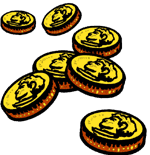How Coins Are Made
Updated February 21, 2017 | Factmonster Staff 

Source: The U.S. Mint
 |
| Step 1: Blanking | The U.S. Mint buys strips of metal about 13 inches wide and 1,500 feet long to manufacture the nickel, dime, quarter, half-dollar, and dollar. The strips come rolled in a coil. Each coil is fed through a blanking press, which punches out round discs called blanks. The leftover strip, called webbing, is shredded and recycled. (To manufacture the cent, the Mint buys ready-made blanks after supplying fabricators with copper and zinc.) |
| Step 2: Annealing, Washing and Drying | The blanks are heated in an annealing furnace to soften them. Then, they are run through a washer and dryer. |
| Step 3: Riddling | The shiny blanks are sorted on a “riddler” to screen out any that are the wrong size or shape. |
| Step 4: Upsetting | Next, the good blanks go through an upsetting mill. This raises a rim around their edges. |
| Step 5: Striking | Finally, the blanks go to the coining press. Here, they are stamped with the designs and inscriptions, which make them genuine United States coins. |
| Step 6: Inspecting | A press operator uses a magnifying glass to spot-check each batch of new coins. Then all the coins go through a coin sizer to remove any misshapen or dented ones. |
| Step 7: Counting and Bagging | An automatic counting machine counts the coins and drops them into large canvas bags. The bags are sewn shut, loaded on pallets, and taken by forklifts to be stored in vaults. New coins are shipped by truck to Federal Reserve Banks. From there, the coins go to your local bank! |
